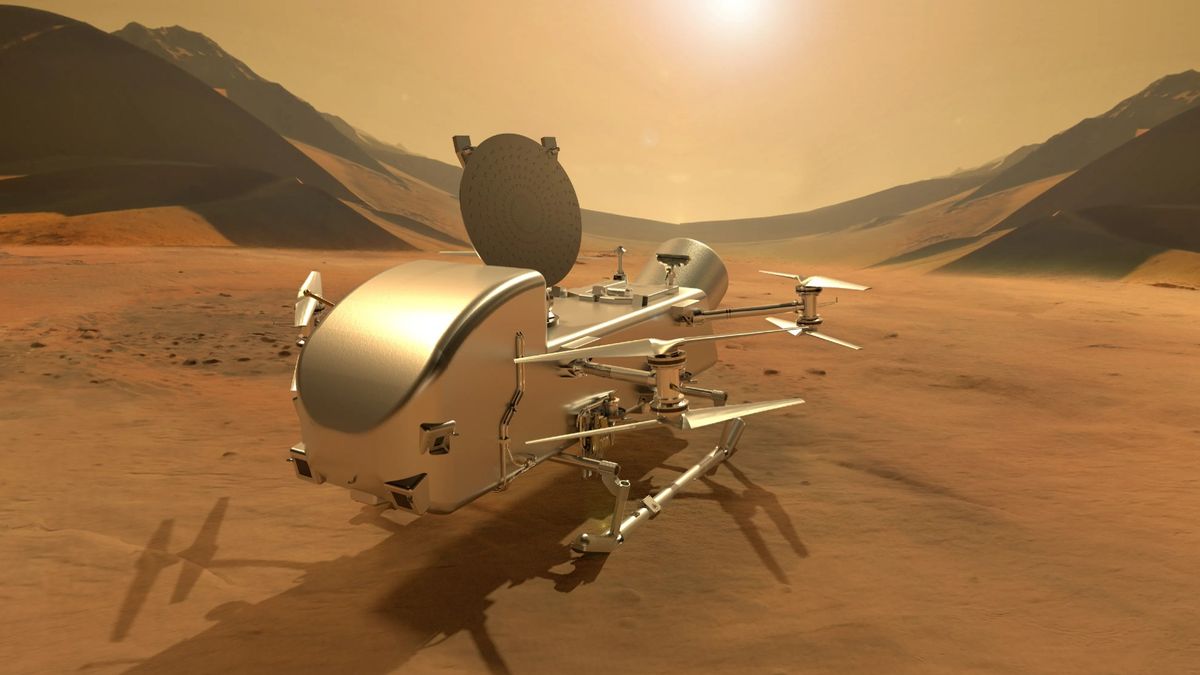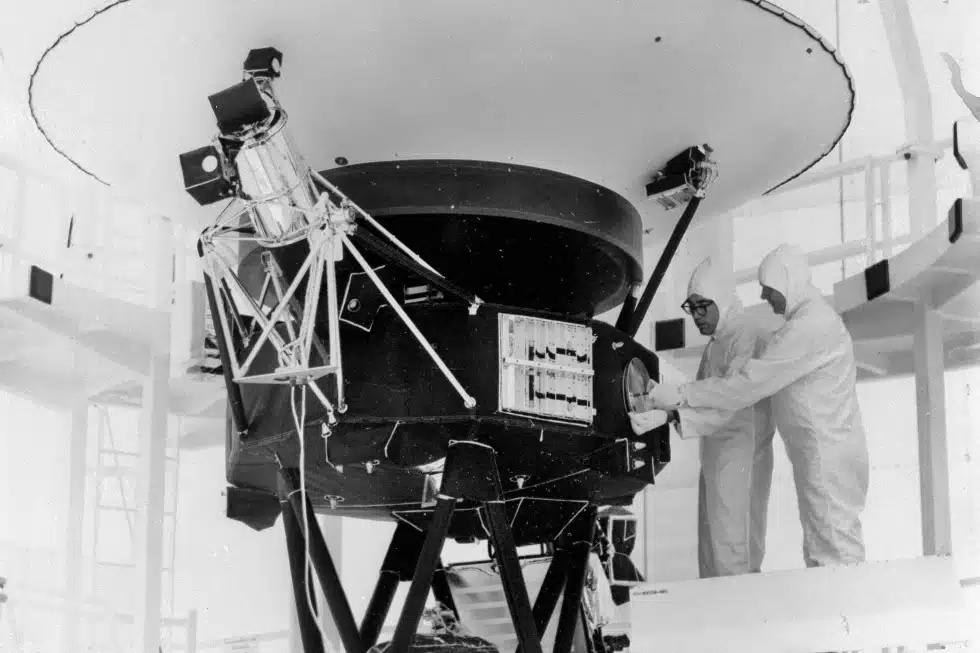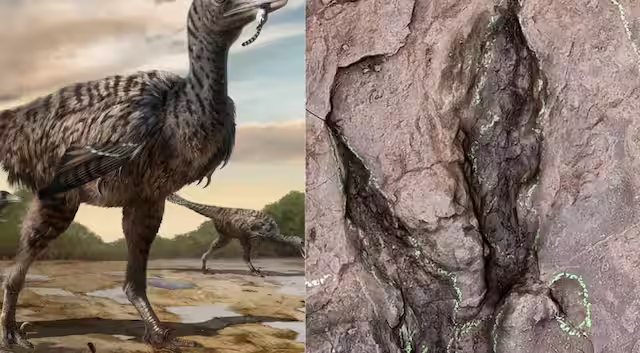Science
Watch: NASA Wants to Fly this Nuclear Dragonfly Drone on Saturn’s Moon Titan

(CTN News) – NASA’s Dragonfly rotorcraft is currently undergoing comprehensive testing in preparation for its ambitious mission to explore Titan, Saturn’s largest moon. The testing is vital to ensure the rotorcraft’s ability to withstand the unique environmental conditions on Titan.
Mission Objective: Unveiling Titan’s Mysteries
Dragonfly’s primary objective is to unravel the complex chemistry of Titan, shedding light on the potential origins of life within our solar system.
Equipped with cameras, sensors, and samplers, this car-sized aerial drone will investigate areas on Titan known to contain organic materials. Of particular interest are regions where these materials may have come into contact with liquid water beneath the moon’s icy surface in the past.
To traverse Titan’s nitrogen-rich atmosphere, Dragonfly is designed with four dual-coaxial rotors. Ensuring that these rotors can perform optimally under the moon’s challenging conditions is a top priority for the Dragonfly team.
Numerous tests have been conducted at NASA‘s Langley Research Center in Hampton, Virginia, including operating the drone’s rotors in a wind tunnel capable of simulating the atmospheric conditions on Titan.

Rigorous Testing Process
The Dragonfly testing process has been divided into four campaigns, with two taking place in a 14-by-22-foot subsonic tunnel and the other two in a 16-foot Transonic Dynamics Tunnel (TDT).
The subsonic tunnel is used to validate fluid dynamic models developed by mission scientists, while the TDT’s variable-density heavy gas capability simulates atmospheric conditions that Dragonfly is likely to encounter on Titan.
The most recent testing, conducted in June, involved a half-scale Dragonfly model and included hundreds of test runs. According to Bernadine Juliano, APL’s test lead for the project, these tests covered a wide range of wind speeds, rotor speeds, and flight angles to assess the vehicle’s aerodynamic performance.
Over 700 total runs were completed, generating more than 4,000 individual data points. This data will significantly boost confidence in simulation models on Earth before they are extrapolated to Titan conditions.
Data Analysis and Collaboration
The analysis of this wealth of data is a collaborative effort involving specialists from various institutions, including the University of Central Florida and NASA Ames Research Center in Silicon Valley.
Rick Heisler from APL, who oversaw the TDT test campaigns, emphasized the value of these tests in understanding Dragonfly’s rotor performance in Titan’s unique atmosphere. The heavy gas environment in the TDT replicates conditions on Titan closely, allowing for a more accurate assessment of rotor performance.
The Significance of Dragonfly’s Mission
As the pieces of the Dragonfly mission come together, the team is increasingly aware of the historic nature of their task. Ken Hibbard, Dragonfly mission systems engineer at Johns Hopkins Applied Physics Laboratory, highlighted the importance of this mission, saying, “With Dragonfly, we’re turning science fiction into exploration fact.”
The team is enthusiastic about every step taken towards sending this revolutionary rotorcraft across the skies and surface of Titan, bringing us closer to uncovering the mysteries of this fascinating moon.
The testing and preparations for Dragonfly’s mission mark a significant milestone in our quest to explore the depths of our solar system and uncover the secrets of potential life beyond Earth.
SEE ALSO: NASA Launches Psyche Metal Asteroid Mission: What You Need to Know

Science
NASA Switches Off Instrument On Voyager 2 Spacecraft To Save Power

NEW YORK — To save power, NASA turned off another scientific equipment on its long-running Voyager 2 spacecraft.
NASA Switches Off Instrument On the Spacecraft To Save Power
The space agency announced on Tuesday that 2’s plasma science instrument, meant to study the movement of charged atoms, was turned off in late September to allow the spacecraft to continue exploring for as long as possible, which is estimated to be into the 2030s.
NASA turned off a suite of instruments on Voyager 2 and its twin, Voyager 1, after exploring the gas giant planets in the 1980s. Both are currently in interstellar space or the region between stars. The plasma instrument on Voyager 1 stopped working years ago and was finally shut off in 2007.
The remaining four instruments on 2 will continue to collect data on magnetic fields and particles. Its mission is to investigate the regions of space beyond the sun’s protective sphere.
NASA Switches Off Instrument On Voyager 2 Spacecraft To Save Power
It launched in 1977, is the only spacecraft to have visited Uranus and Neptune. It is now more than 12 billion miles (19.31 billion kilometers) from Earth. 1 is more than 15 billion miles (24.14 billion kilometers) beyond Earth.
SOURCE | AP
Science
Hurricane Kirk Could Cause Dangerous Surf Conditions Along The US East Coast

MIAMI — Hurricane Kirk’s waves could generate life-threatening surf and rip current conditions this weekend throughout the United States East Coast, as well as in Bermuda, the Greater Antilles, and the Bahamas, according to forecasters.
Kirk was a Category 3 hurricane in the middle Atlantic Ocean that might grow further but was predicted to stay away from land, according to the Miami-based National Hurricane Center on Thursday.
Hurricane Kirk Could Cause Dangerous Surf Conditions Along The US East Coast
Kirk-generated swells were forecast to reach parts of the Leeward Islands on Friday, Bermuda and the Greater Antilles on Saturday, and the East Coast and the Bahamas on Sunday, according to the center.
No coastal watches or warnings were in effect. The major storm was around 1,130 miles (1,820 kilometers) east of the Leeward Islands, with maximum sustained winds of 125 mph (205 km/h).
Meanwhile, Tropical Storm Leslie formed late Wednesday in the eastern Atlantic and is expected to strengthen into a hurricane in the following days, forecasters said. It was also not considered a threat to the land.
Hurricane Kirk Could Cause Dangerous Surf Conditions Along The US East Coast
The storm was about 540 miles (870 kilometers) southwest of Cabo Verde’s southernmost tip, with maximum sustained winds of 45 mph (75 kph), according to the center.
The storms raged in the Atlantic as rescuers in the United States Southeast sought for missing persons after Hurricane Helene struck last week, leaving a trail of death and devastation.
SOURCE | AP
Science
Giant Fossilised Footprint Of Dinosaur Found in China

(CTN News) – A team of palaeontologists believes they have discovered fossilized footprints of one of China’s largest raptors. The collection of five fossilized dinosaur footprints is half the length of a school bus.
The footprints were discovered in a dinosaur trackway in south-east China in 2020. Scientists believe dinosaurs walked over the muddy river during the Cretaceous period, leaving footprints. Some footprints have been preserved for tens of millions of years.
The dinosaur trackway was unearthed in Longxiang and is around the size of a hockey rink. Some of the footprints are unusually formed, with intact imprints of only two toes.
Fossilised footprint of megaraptor found in China

Giant fossil footprints lead to megaraptor dinosaur discovery in China
Raptors, or predatory birds, are often small and referred to as deinonychosaurs. For example, a Velociraptor is around the size of a turkey. Few raptors, such as the Utahraptor and Dakotaraptor, increased in size significantly, reaching lengths of 5 to 6 metres. The Triassic ichthyosaur was the largest raptor known until now.
According to the scientists, the predator would have attacked its prey with a pair of huge “killing claws” on each foot.
What scientists discovered recently in China is massive, far larger than the largest superpredator known to date.
Scott Persons of the College of Charleston in South Carolina, and his colleagues, added another large raptor to the list. They named it Fujianipus, and they believe it lived in East Asia some 96 million years ago.

Scott Persons at the College of Charleston in South Carolina and his colleagues added another giant raptor to the list. They named it Fujianipus, and they say it lived in East Asia about 96 million years ago. Photograph:(Twitter)
Persons and his colleagues are currently working on areas of Fujianipus’ skeleton, therefore little is known. The investigators only discovered a few of its 36-centimetre-long imprints.
“Preservation conditions were right for footprints but not so great for bones,” Persons said. However, scientists are certain that the footprints belong to a raptor because each one contains the imprint of only two toes, which corresponds to the foot anatomy of raptors. Raptors generally have three toes, but they keep one off the ground to preserve the big claw at the tip from wear and tear.
People believe Fujianipus demonstrates that raptors had the ability to grow much larger and compete with the largest predatory dinosaurs on the landscape at the time – allosauroids, some of which exceeded 10 metres or more in length.
According to Persons, raptors had an advantage over allosauroids in terms of speed. However, without fossilized leg bones, the researchers cannot correctly measure Fujianipus’ speed.
-

 News4 years ago
News4 years agoLet’s Know About Ultra High Net Worth Individual
-
Entertainment2 years ago
Mabelle Prior: The Voice of Hope, Resilience, and Diversity Inspiring Generations
-
News11 years ago
Enviromental Groups Tell Mekong Leaders Lao Dam Evaluation Process Flawed
-

 Health4 years ago
Health4 years agoHow Much Ivermectin Should You Take?
-

 Tech3 years ago
Tech3 years agoTop Forex Brokers of 2023: Reviews and Analysis for Successful Trading
-

 Lifestyles3 years ago
Lifestyles3 years agoAries Soulmate Signs
-

 Entertainment3 years ago
Entertainment3 years agoWhat Should I Do If Disney Plus Keeps Logging Me Out of TV?
-

 Health3 years ago
Health3 years agoCan I Buy Ivermectin Without A Prescription in the USA?
